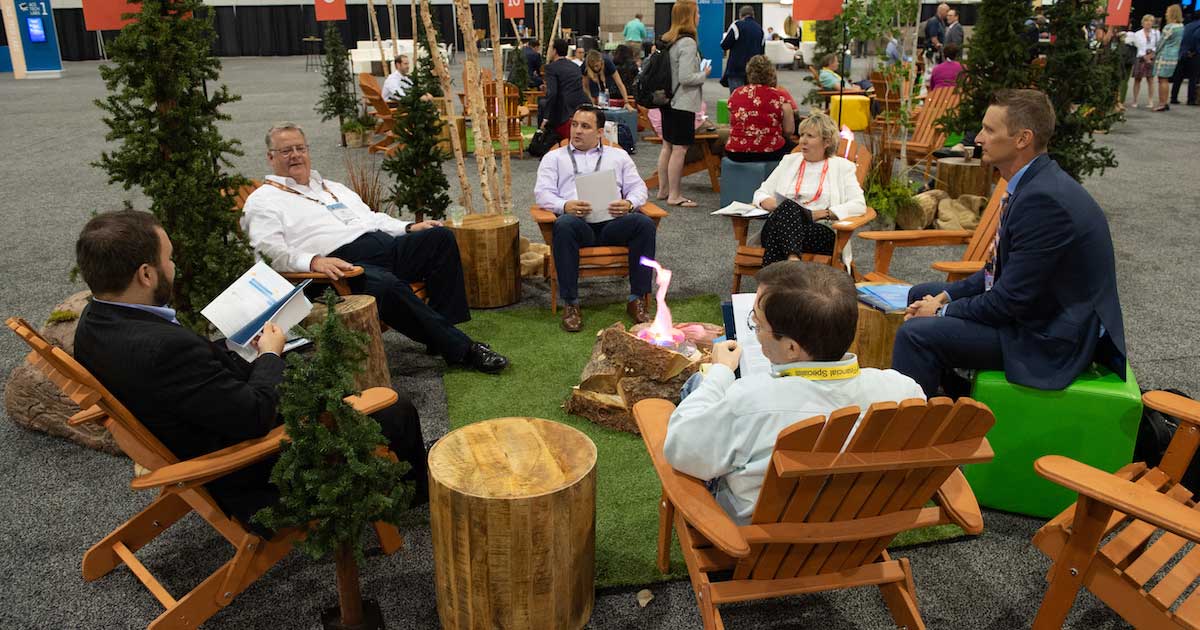Headquartered in Southern California, Cetera Financial Group is a financial services corporation with the second-largest family of independent broker-dealers in the U.S. Colleen M. Connor, CMP (MPI San Diego Chapter), vice president/head of conferences, joined Cetera in 2018, the first year of combining five smaller annual conferences of their family of firms into one large annual event.
Connect 2019 in Denver really hit its stride. Connor explains to The Meeting Professional the challenges and triumphs involved when making a large conference feel small and personalized by leveraging principles of experience design.
The Meeting Professional: For our readers, can you give use some details about your annual conference, Connect?
Colleen Connor: The Connect conference was reimagined in 2018 when our family of firms brought their individual national conferences together for one larger conference as a result of strategic alignment and growth. Each of the smaller conferences was about 500 people, and now our attendance is close to 4,000, which includes product partners, employees and our clients, who are financial professionals. The objective of the meeting is to bring together our family of firms to highlight the tools and services we offer our clients in an environment designed for networking and building community.
TMP: While some of the attendees are company employees, many are independent business owners. How does that affect your conference design?
CC: With such a variety of attendees, we have to know what drives them. They work in institutions and corporations, in large and small companies with a variety of cultures. But they are all financial professionals and our common goal is to equip them with tools to thrive in their businesses. As designers of the experience, we need to make sure they find their identity with Cetera while still finding their interest groups and communities on a smaller level.
TMP: What are some of the challenges you’ve faced with designing the conference?
CC: One of the largest challenges with this conference is finding the balance of keeping the individual firms’ cultures and traditions with making the attendees still feel important and valued in a larger conference environment. One solution: We created individual firm lounges within our large non-traditional exhibit hall experience.
TMP: What do you mean by non-traditional exhibit hall?
CC: Connect uses a large convention hall but we don’t use booths. We created regions for learning and collaborating throughout the floor with décor to make the space feel inviting and warm. We wanted to bring the outdoors inside, reflective of our Colorado setting. We used many natural elements and a camp theme like Adirondack chairs for discussion groups and campfires and focused messaging around elevating their businesses and themselves.
TMP: Collaborating with partners during the design process is critical. How did they help you craft this experience?
CC: Our key partners were Maritz Travel, GES, Etage Inc., Showtec, Marx Productions, PRA and Visit Denver. We needed every one of these partners to collaborate and execute our vision. We created the framework and they worked together seamlessly.
TMP: We know that best practices in event experience design include elements to make them immersive, participatory, authentic and customized. How have you infused some of these elements into Connect?
CC: All of our session content is curated to highlight how to create growth, operational efficiencies and technology to support our clients’ businesses. We offer hands-on training of technology platforms, and our networking events have immersed the attendees in the destination where we are hosting the event. We also allow the attendees to build their personalized agenda in advance using an online tool. We also have an onsite mobile app to enhance engagement. In 2019, we used the mobile app to create locations around the conference to “scan in” to encourage the attendees to see all aspects of the conference. We’ve done puppy wellness breaks and yoga/stretching wellness breaks that allow attendees to disengage from educational sessions and give their mind a rest to reset. We’ve highlighted local nonprofits and offered our attendees the opportunity to donate. Last year in Denver we highlighted Youth on Record and integrated their musicians into our programming to showcase who the donations were supporting.
TMP: Wonderful give-back to the local music community. Denver has an authentic, unique personality. How else did you incorporate the local flavor of Denver into your conference?
CC: The entire vibe resonated with the destination—bringing the outside in. We explored other local options like craft beer pairing with dishes and infusing every dish with beer. The Centerplate team at the Denver Convention Center did a great job in helping us highlight a taste of Denver in our menus. The destination also helped us donate our furniture from our Fireside Chats to local parks and recreation departments. Something I’d never seen before is Visit Denver recycled our citywide banners, turning them into reusable bags that they shipped back to us.
TMP: For the learning and content delivery, what boundaries did you push or chances did you take?
CC: We created hands-on learning areas on our show floor in regions, using earbuds to focus sound in the small areas. We had six- to eight-person, facilitated fireside chats people could sign up for, as well as larger table discussions. These conversations were hosted by a sponsor or home office representative but were facilitated conversations instead of presentations. Peer-to-peer learning is a priority for our group.
TMP: It sounds amazing! With so much success, what are some ideas to evolve the conference next time?
CC: We want to continue to create more innovative ways to deliver content and curate more ways for the attendees to engage with each other. The biggest learning is that everyone wants to feel important and included with a sense of community. We strive to make that happens at every conference. Special touches are important. For example, for the attendees from a newly acquired firm, we had a special note put in the computer so upon their arrival one of my staff personally greeted them and introduced herself to be sure they felt welcome. They came from a much smaller firm and this helped their experience tremendously.
Authentic F&B Experiences
Vikki Kelly, convention services director at Visit Denver, describes how they partner with clients to build authentic experiences through food and beverage: “We create menus that feature local farms, restaurants and products that bring in our sustainability principals. Denver has more than 100 breweries and brew pubs in the metro area and now is also home to many craft distilleries. This Colorado craft movement is perfect for highlighting the personality of our region through events—people want to eat and drink local. And they wouldn’t feel the spirit of the great plains if we didn’t pair our local brews with some unique options like elk or buffalo.
Level Up Your Experience Design
Visit mpi.org/blogto hear more from Colleen Connor: how she encouraged adoption internally and the mistakes she learned from the design phases.
You can also join our online Experiential Marketers and Designers Community. And if you’re not an MPI member, learn more about joining and the value of belonging to this community.
If you’re ready to take the next step in experience design, enroll in one of our upcoming Event Design Certificate courses today.
Each month during 2020, Annette Gregg, CMM, MBA, senior vice president of experience for MPI, will interview MPI members to highlight some of the best examples of event experience design (or user-centered design) across the globe. Look for the reports in every issue of The Meeting Professional.
Photo by Dean Stevenson Photography.







